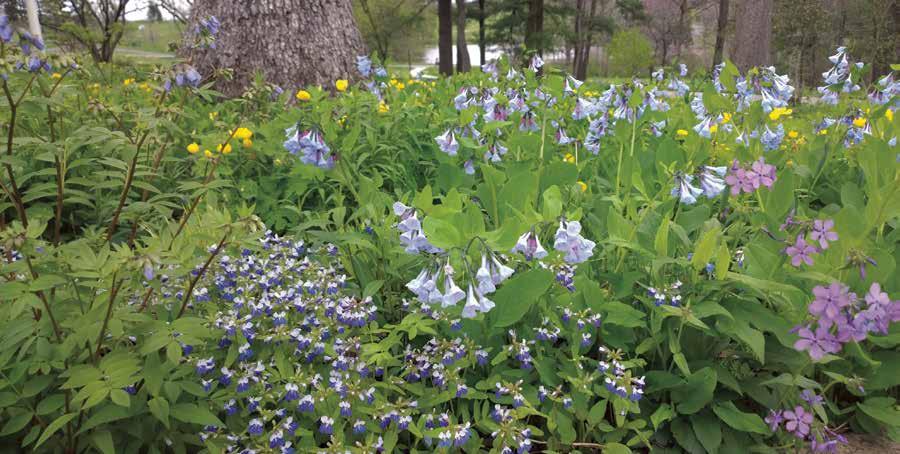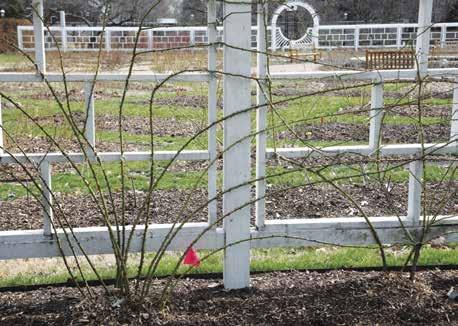
5 minute read
Natives for Under Trees
Naturally Natives
Naturalizing Native Plants Under Trees text and photos by Scott Woodbury
Wood poppies, Jacob’s ladder, Virginia bluebells, blue-eyed Mary, and wild sweet William.
Missouri Wildflowers Nursery
9814 Pleasant Hill Rd Jefferson City MO 65109 www.mowildflowers.net mowldflrs@socket.net
573-496-3492
Meet us at one of these locations in the St. Louis area. Give us your order by Tuesday before a sale, and we will bring it to the location. Plants purchased at events away from the nursery cost 10% more, which covers sales tax and shipping. This costs less than having them shipped UPS from the nursery. Kirkwood Farmer’s Market, 150 East Argonne Dr. Kirkwood MO 63122. Give us your order in advance, or pick from the selection at the market. April 3, 10, 17, 24, and May 1, 22, 29; 8 a.m. to 4 p.m. Shaw Nature Reserve, 307 Pinetum Loop Rd, Gray Summit, MO 63039. Event: “Shaw Wildflower Pickup-Up www.shawnature.org. May 8, 9 a.m. to 1 p.m. No Friday sale this year. Opening day at our Brazito (Jefferson City) location is March 21. Our retail “store” (outdoor sales area) is open for you to make selections. You can also send a pre-order and pick it up at the nursery. Please practice physical distancing and wear a mask when you arrive. We can ship your order! We ship plants on Mondays, Tuesdays and Wednesdays all year. UPS usually delivers the next day in Missouri and to the middle of surrounding states. Shipping charges apply. If you are struggling to grow lawn under the shade of trees, then maybe it’s time to unleash a patch of woodland wildflowers. Virginia bluebell (Mertensia virginica), wood poppy (Stylophorum diphyllum), Jacob’s ladder (Polemonium reptans), wild geranium (Geranium maculatum), woolen britches (Hydrophyllum appendiculatum), yellow violet (Viola pennsylvanica), wild sweet William (Phlox divaricata), roundleaf groundsel (Packera obovata), and columbine (Aquilegia canadensis) are all spring-blooming species that work well naturalized beneath the high branches of oak, sweet gum, or black walnut trees. Because many spring wildflowers go dormant by summer, mix in sensitive fern (Onoclea sensibilis), Maidenhair fern (Adiantum pedatum), or Ostrich fern (Matteuccia struthiopteris) to fill in gaps that appear mid-season and provide structure. Shrubs, including smooth hydrangea (Hydrangea arborescens), beautyberry
Horticulturist Scott Woodbury is the Curator of the Whitmire Wildflower Garden at Shaw Nature Reserve in Gray Summit, MO, where he has worked with native plant propagation, design, and education for 30 years. He also is an advisor to the Missouri Prairie Foundation’s Grow Native! program.
Tips and Resources for Growing and Landscaping with Sustainable Native Plants
(Callicarpa americana), and shrubby St. John’s Wort (Hypericum prolificum) are all shade tolerant and help provide year-round structure. Summer and fall bloomers round out the season. They include purple coneflower (Echinacea purpurea), star coreopsis (Coreopsis pubescens), downy skullcap (Scutellaria incana), showy goldenrod (Solidago speciosa), Ohio horsemint (Blephilia ciliata), sweet coneflower (Rudbeckia subtomentosa), American bellflower (Campanula Americana) and eastern blazingstar (Liatris scariosa). Don’t forget grasses and sedges. I recommend starting with a few woodland rye (Elymus virginicus), bottlebrush grass (Elymus hystrix), American beakgrain (Diarrhena obovata) or river oats (Chasmanthium latifolium). Sedges like palm (Carex muskingumensis), oak (C. albicans), star (C. radiata), Pennsylvania (C. pennsylvanica), and cattail (C. typhina) add a fine-textured contrast to the wildflowers. Remember that in nature, grasses and flowers are randomly mixed like a tossed salad. This approach will look terrific beneath the trees in your yard as well. Start your project in February or March by killing an area of turf grass about 200 square feet (10 x 20). If you are ambitious, double or triple this amount. This can be done by pinning down a tarp or a piece of plastic for 8 to 10 weeks in the shade of medium (40+ feet) to large trees (60+ feet), possibly circling the trunk of one. Then remove the covering, install your plants, lay 2 inches of ground leaf mulch on the bare soil, and water immediately. (Avoid cutting medium to large tree roots while planting large container plants.) If it doesn’t rain, water weekly and finally, keep the weeds out. Remove lower tree branches to a height of 15 feet for medium trees and 25 feet for large trees to allow indirect side-light to enter the garden. I like to install plants 18 to 20 inches apart. This way, plants grow in thickly by the following season and work to crowd out some of the weeds. To calculate the number of plants needed, there is a helpful plant calculator at classygroundcovers.com. Plant in a triangular pattern. For example, if your planting area is 200 square feet, and you are planting 18 inches apart, then you will need 103 plants total. At 20 inches apart, you will need 83 plants. If you are planting on a budget, consider buying plugs or small pots and plant 24 inches apart (58 plants). The next year in April, look for new seedlings that will begin to appear and spread. You may expand the planting area outward to make it bigger or dig up and move seedlings to create new beds. This is what I mean by unleashing woodland wildflowers. They will spread by themselves, especially if you rake up tree leaves in February or March so that new seedlings can germinate in April and grow in the bare spaces, unencumbered by a thick layer of leaves. In February or March, trim spent foliage and stems to a height of 8 to 22 inches. Many species of native bees nest in dead stems. New plant growth in April will hide the stubble. What are you waiting for? It’s time to unleash woodland wildflowers in a shaded space near you. What could be more fun and beneficial to human and wildlife health? Happy gardening! Wood poppies and ostrich ferns.


...the days will lengthen, the ice will melt in the pasture pond. The song sparrow will return and sing, the frogs will awake, the warm wind will blow again. All these sights and sounds and smells will be yours to enjoy… this lovely world, these precious days…
~ E.B. WHITE, “CHARLOTTE’S WEB”




